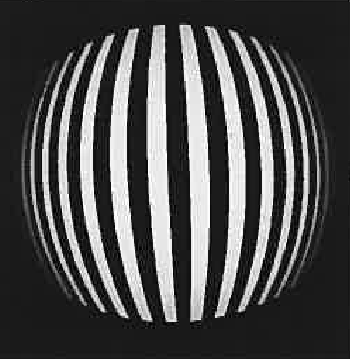Reconstruction active et passive en vision par ordinateur
memoire » Ph.D.Jean-Philippe Tardif
Tags: calibration , self-calibration , omnidirectional vision , radial distortion , matching , structured light , factorization , 3D reconstruction , computer vision
Date : 2007-08
Papyrus
http://hdl.handle.net/1866/17874Abstract
 In this thesis, we propose solutions for several problems encountered in the fteld of active and passive 3D reconstruction in computer vision. Our contributions are related to three topics: self-calibration, reconstruction and factorization. The first topic relates to the problem of calibration and seif-calibration of pin-hole, wide-angle and fisheye cameras, as well as many catadioptric cameras possibly with view angle larger than 180° and also with a non-single viewpoint. We propose the generat radiatty symmetric camera model with central or non-central projection. It provides a unified representation of the projection function of all the above cameras. The camera is modeled using a set of virtual pinhole cameras with identical optical axis, each of them associated with a circle of the image centered in the distortion center. Many kinds of distortion can be represented by allowing the virtual cameras to have different focal length. This variation can be represented either by a discrete or a parametric function. We propose three plane-based calibration algorithms for the central-projection model and another one for the non-central case. Furthermore, we propose two self-calibration algorithms for the case of central projection. The first one is a plumbline method and the second one uses feature correspondences in at least two views of a planar scene. The second topic concerns the active matching between a multimedia projector and a camera using structured light patterns. Our contribution is a probabilistic approach to decode the patterns that can correct errors induced by the binarization of the images. Furthermore, it provides smoothing of the codes while preserving discontinuities. The third topic is the non-linear problem of matrix factorization with missing data. An algorithm performing this task is very useful tool because many vision problem can be formulated in this way. Among them, there are the problems of affine and perspective 3D reconstruction as well as 3D reconstruction under varying and unknown illumination. In general, the factorization problem is solved by launching many iterative minimization initialized using random solutions. The process is slow and, most of the time, the minimization get stuck into a local minimum. We propose a novel batch algorithm that proceeds by computing constraints on the first factor using complete sub-blocks of the measurement matrix. These are combined together to allow the estimation of the first factor by solving a convex minimization problem. We propose generalized closure constraints, new dual constraints called basis constraints and an algorithm for finding complete sub-blocks. The algorithm is very fast and provides close to optimal solutions. Furthermore, our method can provide a starting point for iterative methods and significantly improve their convergence rate. Also, we provide alternative closure and basis constraints specifically designed for the problem of passive 3D reconstruction. We perform a careful analysis of the affine model, for which we obtain very good resuits even without refining the reconstruction by using an iterative algorithm.
In this thesis, we propose solutions for several problems encountered in the fteld of active and passive 3D reconstruction in computer vision. Our contributions are related to three topics: self-calibration, reconstruction and factorization. The first topic relates to the problem of calibration and seif-calibration of pin-hole, wide-angle and fisheye cameras, as well as many catadioptric cameras possibly with view angle larger than 180° and also with a non-single viewpoint. We propose the generat radiatty symmetric camera model with central or non-central projection. It provides a unified representation of the projection function of all the above cameras. The camera is modeled using a set of virtual pinhole cameras with identical optical axis, each of them associated with a circle of the image centered in the distortion center. Many kinds of distortion can be represented by allowing the virtual cameras to have different focal length. This variation can be represented either by a discrete or a parametric function. We propose three plane-based calibration algorithms for the central-projection model and another one for the non-central case. Furthermore, we propose two self-calibration algorithms for the case of central projection. The first one is a plumbline method and the second one uses feature correspondences in at least two views of a planar scene. The second topic concerns the active matching between a multimedia projector and a camera using structured light patterns. Our contribution is a probabilistic approach to decode the patterns that can correct errors induced by the binarization of the images. Furthermore, it provides smoothing of the codes while preserving discontinuities. The third topic is the non-linear problem of matrix factorization with missing data. An algorithm performing this task is very useful tool because many vision problem can be formulated in this way. Among them, there are the problems of affine and perspective 3D reconstruction as well as 3D reconstruction under varying and unknown illumination. In general, the factorization problem is solved by launching many iterative minimization initialized using random solutions. The process is slow and, most of the time, the minimization get stuck into a local minimum. We propose a novel batch algorithm that proceeds by computing constraints on the first factor using complete sub-blocks of the measurement matrix. These are combined together to allow the estimation of the first factor by solving a convex minimization problem. We propose generalized closure constraints, new dual constraints called basis constraints and an algorithm for finding complete sub-blocks. The algorithm is very fast and provides close to optimal solutions. Furthermore, our method can provide a starting point for iterative methods and significantly improve their convergence rate. Also, we provide alternative closure and basis constraints specifically designed for the problem of passive 3D reconstruction. We perform a careful analysis of the affine model, for which we obtain very good resuits even without refining the reconstruction by using an iterative algorithm.